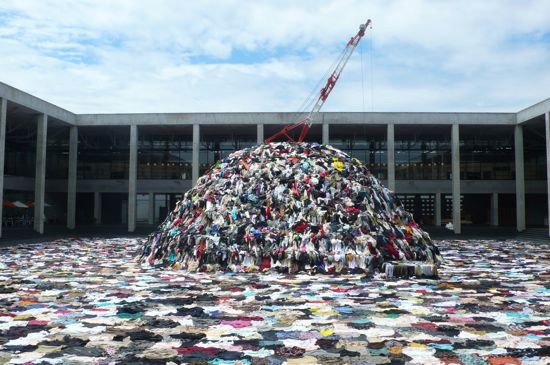 Installation view of Christian Boltanski’s No Man’s Land at the Echigo-Tusmari Satoyama Museum of Contemporary Art, Kinare, 2012. Photo ART iT.
Installation view of Christian Boltanski’s No Man’s Land at the Echigo-Tusmari Satoyama Museum of Contemporary Art, Kinare, 2012. Photo ART iT.The Echigo-Tsumari Art Triennial has opened its fifth edition Jul 29. Launched in 2000, the Echigo-Tsumari Art Triennial is at the forefront of a wave of large-scale initiatives in Japan seeking to combine art with urban and regional regeneration. Over the years the art festival has commissioned projects – many of them permanent – by artists ranging from Marina Abramovic to Christian Boltanski and Cai Guo-Qiang, placed in abandoned schools and homes in this rural mountainous region of Niigata prefecture that has seen economic decline and depopulation issues.
Growing awareness of and support for the event have led to significant changes to the local landscape. This year’s edition sees the inauguration of a new institution, the Echigo-Tusmari Satoyama Museum of Contemporary Art, Kinare, housed in a building in the city of Tokamachi designed for the 2003 edition of the festival by architect Hiroshi Hara. Works on display here include Christian Boltanski’s massive installation No Man’s Land, made of scores of items of used clothing heaped into a pile that is repeatedly picked up and dropped by a mechanized crane. After high-profile presentations in Paris and New York, the work now fills the central courtyard of the Kinare building. Inside, works include those by an eclectic selection of artists such as Leandro Erlich, Elmgreen & Dragset and Carsten Nicolai, as well as a sleek bar and reading space designed by Massimo Bartolini.
Books also feature prominently at the former school building that has been rechristened the Echigo-Tsumari Archive CIAN (Interlocal Art Network Center). In the second-story gymnasium, artist Tadashi Kawamata has created a massive sculptural structure to house the personal library of critic and curator Yusuke Nakahara, who died in 2011 just days before the March 11 earthquake, tsunami and nuclear disaster. The project’s intent is to give insight into the mind of one of Japan’s most influential thinkers in art, whose holdings included monographs, catalogues and studies in multiple languages on topics ranging from Eva Hesse to Kazimir Malevich and Italian Futurism.
Other highlights include the return of Australia House, a platform for cultural exchange between Australia and Japan, which was destroyed by the March 11 earthquake and has been rebuilt according to a design by Andrew Burns Architect of Sydney. Incorporating both Japanese and modernist principles in its design, the new building is a severe, angular structure with long open spaces along the length of its facade, creating a sense of permeability between interior and exterior.
As with previous editions, this year’s art festival is overseen by Fram Kitagawa, with support from both public administrations and private sponsorship. This year’s art advisors are Hans Ulrich Obrist of the Serpentine Gallery in London and the independent curator Huang Du. The official exhibition period continues through Sep 17.
For more information
See also:
Tadashi Kawamata: The Radius of Action
